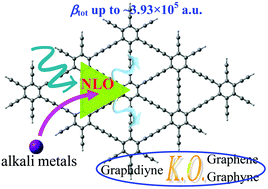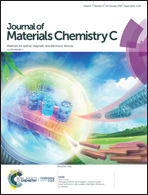Investigations of electronic and nonlinear optical properties of single alkali metal adsorbed graphene, graphyne and graphdiyne systems by first-principles calculations†
Abstract
Novel two-dimensional (2D) materials with promising and tunable nonlinear optical (NLO) properties are desirable for the development of optoelectronic nanodevices. Here, the geometric structures, electronic properties, and nonlinear optical responses of graphene (GE), graphyne (GY), and graphdiyne (GDY) complexes with single adsorbed alkali metals (AM: Li, Na, K) were systematically investigated using density functional theory calculations. All the alkali metals are energetically preferred for interacting with the large triangular holes in extensively delocalized π-conjugated graphyne and graphdiyne via an intramolecular electron donor–acceptor (D-π-A) process and can be stabilized by van der Waals interactions. Moreover, AM@GY and AM@GDY (AM = Li, Na, K) exhibit dramatically higher structural stability than AM@GE owing to their high binding energies. The effects of doping alkali metal atoms into the surface of GDY on the electronic structures were investigated by an analysis of the HOMO–LUMO gap and density of states. The strong alkalide characteristics of these complexes can be demonstrated by their NBO charges and lower vertical ionization potentials (VIPs). In addition, the adsorption of alkali metals greatly increases the first hyperpolarizability (βtot), and AM@GDY possesses exceptionally high βtot values (8.57 × 104 to 3.93 × 105 a.u.) in comparison with AM@GE and AM@GY owing to its unique structural patterns. The frequency dependences of the electro-optical (EO) Pockels effect and second-harmonic generation (SHG) were analyzed in order to investigate the dynamic NLO process, and it was revealed that SHG resonance enhancement takes place at ω = 0.10 a.u. The present investigation not only highlights the importance of the adsorption of single alkali metals on the surface of GDY for enhancing its NLO properties but also indicates that AM@GDY complexes are potentially important materials for next-generation graphdiyne-based optoelectronics applications.

- This article is part of the themed collection: 2019 Journal of Materials Chemistry C Most Popular Articles


 Please wait while we load your content...
Please wait while we load your content...